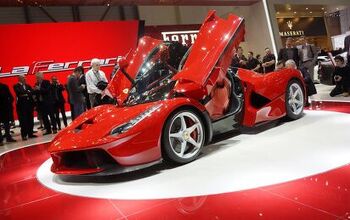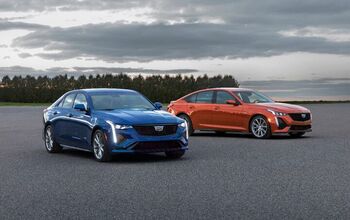Freedom From Choice
In 1817, Marie-Henri Beyle toured the Uffizi museum. Lost in a maze of galleries, the French novelist was paralyzed by indecision. His heart raced. His breathing was shallow and labored. His mind was completely disoriented. He couldn't move. Beyle eventually wrote about his experience under his pen name, Stendahl. In 1979, Italian psychiatrist Graziella Megherini coined the phrase 'Stendahl Syndrome' for people paralyzed by excessive choice. It's a concept bedeviling supermarkets, web pages and… carmakers.
For example, BMW's M5 is considered the ultimate sports sedan. And yet the uber-5er faces a bewildering range of operational decisions: three suspension, shifting and e-traction levels; two horsepower options and eleven gearbox modes. While a hard-core cadre of enthusiasts embrace the Bimmer's programmability, most newbies sit in the M5's driver's seat and… freeze. After overcoming their initial shock, they rely on one or two factory settings– or walk away thanking Gott in Himmel they own something a lot less complicated.
The M5's complexity reflects automakers' overly literal interpretation of America's favorite shibboleth: freedom of choice. Carmakers clearly believe that the more their products cater to each owner's personal preferences, the better. You only have to count the number of motors underneath a S-Class' seat– or tally-up the number of ways it can massage, heat or cool its occupant's hindquarters– to see the philosophy in action. And it's not just the luxury playas kissing ass. Even a humble Hyundai Elantra offers eight-way adjustable seats. This sort of multi-variable "feature creep" is spreading through the automotive landscape like electronic kudzu.
The personalization craze is based on a couple of false assumptions. For one thing, it assumes that people are different. As much as purple dinosaurs would have us believe otherwise, most humans share the same likes and dislikes. Put an Audi MMI interface in front of a wealthy, middle-aged man, and he'll use it (or not) the same way as any other wealthy, middle-aged man: completely ignoring 80% of its functions. If middle-aged men are your core clientele, confronting them with options they don't want or (worse) understand is an indisputably boneheaded idea.
The "options uber alles" movement also assumes that people enjoy experimentation. How do you decide when your M5's chair bolsters should deploy? Which suspension setting is best for the family on a road trip? Technophiles are comfortable "playing" with BMW's buttons until they achieve a suitable result. Regular Joes prefer to leave things as they are (rather than get lost inside an iDrive sub-menu). In both cases, psychological comfort depends on a precise balance between the amount of available choice and a person's ability to understand and evaluate the options. Today's luxury car salesmen spend twice as much time on customer deliveries– explaining functionality– than they did ten years ago. That's a sign of trouble, not progress.
Automotive Stendahl Syndrome isn't restricted to the human – vehicle interface. The industry itself is triggering buyers' instinctual freeze response. Customers must select from literally hundreds of models. Let's say a potential buyer restricts themselves to Ford products. They must then choose from one of eight brands: Ford, Lincoln, Mercury, Mazda, Volvo, Jaguar, Land Rover or Aston Martin. If they take a fancy to Volvo, they must then select a vehicle from eight models: S40, S60, S80, V50, V70, XC70, XC90 or C70. If they opt for an XC90, they then must decide on one of two engine configurations. And then there's the options list… Is it any wonder so many people buy a newer version of their existing whip, rather than face the prospect of Stendahl Syndrome?
Automakers looking to increase customer satisfaction and build their brands should buck the trend and implement a radical, counterintuitive strategy: less choice. First, they must only offer the options and features their core clients really need/want (erring on the side of minimalism). Second, they must make all in-car functions completely intuitive. Third, they must realize that customers are most comfortable choosing between two– count 'em two– options (e.g. heated seat: on or off). Fourth, they should never offer a customer more than three choices for adjusting an in-car device (e.g. driving character: comfort, sport or extreme).
Here's the really tough part: carmakers should only sell three models per brand. I know it sounds crazy, but the average luxury buyer has a better chance of naming the staff at their local Starbuck's than listing Cadillac's entire lineup. By the same token, back in the days when a VW was a Beetle and a bus, the automaker's image was far stronger than it is today. By simplifying their products and scything their range, carmakers would eliminate Stendahl Syndrome, making it easier for customers to choose and enjoy their car. Any way you look at it, that's got to be a good thing.
More by Robert Farago
Latest Car Reviews
Read moreLatest Product Reviews
Read moreRecent Comments
- Sobhuza Trooper That Dave Thomas fella sounds like the kind of twit who is oh-so-quick to tell us how easy and fun the bus is for any and all of your personal transportation needs. The time to get to and from the bus stop is never a concern. The time waiting for the bus is never a concern. The time waiting for a connection (if there is one) is never a concern. The weather is never a concern. Whatever you might be carrying or intend to purchase is never a concern. Nope, Boo Cars! Yeah Buses! Buses rule!Needless to say, these twits don't actual take the damn bus.
- MaintenanceCosts Nobody here seems to acknowledge that there are multiple use cases for cars.Some people spend all their time driving all over the country and need every mile and minute of time savings. ICE cars are better for them right now.Some people only drive locally and fly when they travel. For them, there's probably a range number that works, and they don't really need more. For the uses for which we use our EV, that would be around 150 miles. The other thing about a low range requirement is it can make 120V charging viable. If you don't drive more than an average of about 40 miles/day, you can probably get enough electrons through a wall outlet. We spent over two years charging our Bolt only through 120V, while our house was getting rebuilt, and never had an issue.Those are extremes. There are all sorts of use cases in between, which probably represent the majority of drivers. For some users, what's needed is more range. But I think for most users, what's needed is better charging. Retrofit apartment garages like Tim's with 240V outlets at every spot. Install more L3 chargers in supermarket parking lots and alongside gas stations. Make chargers that work like Tesla Superchargers as ubiquitous as gas stations, and EV charging will not be an issue for most users.
- MaintenanceCosts I don't have an opinion on whether any one plant unionizing is the right answer, but the employees sure need to have the right to organize. Unions or the credible threat of unionization are the only thing, history has proven, that can keep employers honest. Without it, we've seen over and over, the employers have complete power over the workers and feel free to exploit the workers however they see fit. (And don't tell me "oh, the workers can just leave" - in an oligopolistic industry, working conditions quickly converge, and there's not another employer right around the corner.)
- Kjhkjlhkjhkljh kljhjkhjklhkjh [h3]Wake me up when it is a 1989 635Csi with a M88/3[/h3]
- BrandX "I can charge using the 240V outlets, sure, but it’s slow."No it's not. That's what all home chargers use - 240V.































Comments
Join the conversation